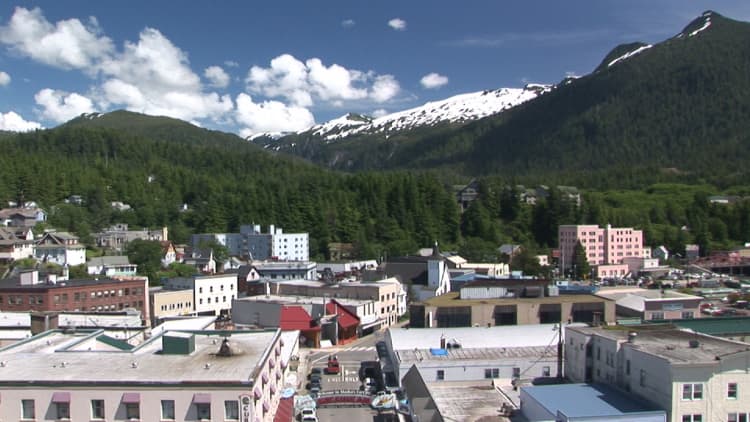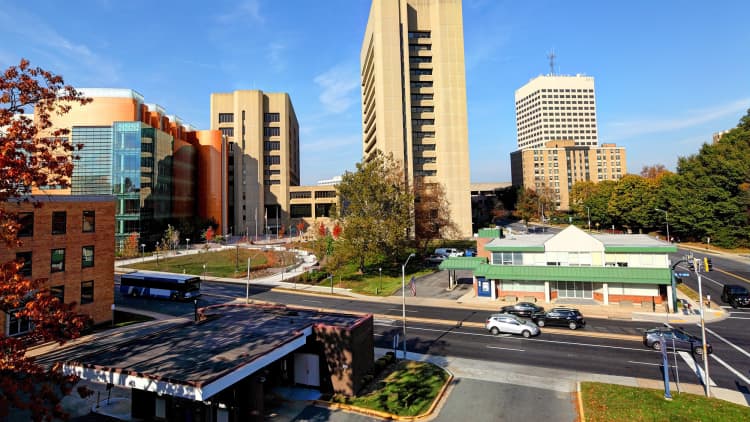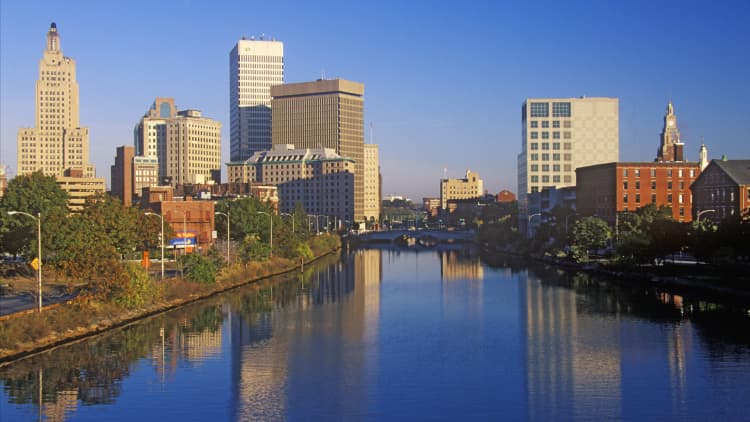Saving money is easier said than done for many people. In a 2017 survey, GOBankingRates found that 57 percent of Americans have less than $1,000 in a savings account.
To find out what's stopping people from saving more money, we asked more than 5,000 adults, "What is the main obstacle that prevents you from saving more money?"
Choices included high cost of living, low salary, debt, not budgeting, no savings account and paying for non-essentials.
More from GOBankingRates:
How do you stack up to the average income in your state?
Keep in mind: Cost of living is low in these 10 cities — but so are salaries
Here's how much debt Americans have
Alabama: Non-essential costs
Alabama is one of the 10 best states to grow your money in 2018, found a recent study. However, growing and saving money can be difficult if you're spending too much on non-essential items.
Nearly 24 percent of respondents stated non-essential costs to be their No. 1 reason for not saving more money in Alabama. As one example, eating out at a cheap restaurant in Birmingham can cost $15, according to Numbeo.
Alaska: No budget/Non-essential costs
According to past research, Alaska is one of the costliest places to live,with less income to spend after paying necessities. Surveyed participants were split between not having a budget and splurging on non-essential costs.
Arizona: High cost of living
Although Arizona is known to be one of the best places for minimum-wage workers, more than 28 percent of residents surveyed said the high cost of living in Arizona is the biggest hiccup to saving more money.
Arkansas: Debt
In a previous GOBankingRates survey, Arkansas ranked as one of the states with the least amount of overall debt. However, it ranks among the states for the most student loan debt, according to an Experian report. Nearly 28 percent of respondents said debt was the main culprit for not saving more money.

California: High cost of living
Nearly 36 percent of respondents credited the Golden State's high cost of living as the main offender for not saving more. In late 2017, the gas tax was raised another 12 cents a gallon, with gas costs exceeding $4 a gallon in parts of the state.
Colorado: High cost of living
Colorado is a relatively expensive place to be a homeowner. The average price of a home is $344,500, according to Zillow. So it's no surprise that nearly 29 percent of respondents stated high cost of living to be a factor in not saving more.
Connecticut: High cost of living
Roughly 33 percent of respondents felt Connecticut's high cost of living prevented them from saving. Within the state, the Bridgeport-Stamford-Norwalk area is the most expensive place to live, according to CNBC.
Delaware: High cost of living
Thirty-six percent of Delawareans said the high cost of living kept them from saving more. The cost of living is 3.5 percent higher than the national average index, according to the Composite Cost of Living index prepared by the Missouri Economic Research and Information Center (MERIC).
District of Columbia: High cost of living
The nation's capital is one of the costliest places to live in the country, especially if you want to own a home. The median home price is $545,400, according to Zillow.
Florida: High cost of living
Living expenses can get quite expensive in Florida. For example, the minimum budget required to survive in Miami for a family of four is $4,700 per month, according to the Miami Herald, which makes living comfortably difficult for the working class.

Georgia: High cost of living
About a quarter of respondents in Georgia said the cost of living was too high to save money. The state has one of the lowest minimum wages in the country at $5.15 per hour. And, one of its cities ranks among the worst places for minimum-wage earners.
Hawaii: High cost of living/No budget
Hawaii is one of the costliest places to live, with $620,400 as the average home price, according to Zillow. Nearly 29 percent of Hawaiians said both the high cost of living and not setting a budget were their main reasons for not saving money.
Idaho: High cost of living
About 28 percent of Idaho residents believed the high cost of living prevented them from saving money. The average price of rent in the state is $764, according to the U.S. Census Bureau.
Illinois: High cost of living
More than 30 percent of respondents said the high cost of living prevented them from saving more. Illinois does have affordable housing markets, with average home prices under $200,000. However, the cost of utilities and transportation tend to be higher than the national average.
Indiana: High cost of living
In the Hoosier State, a high cost of living makes it harder for people to say, according to the survey. The cost of living and the poverty line are rising in the state, with more people qualifying for public assistance, according to Tristate, a local news affiliate.
Iowa: High cost of living/Low salary
Twenty-two percent of Iowans said both the high cost of living and low salaries affected their ability to save. According to the Des Moines Register, the annual pay for an Iowa woman who works full time is only $36,264, which is $11,034 less than a full-time male's salary.
Kansas: High cost of living
Nearly 25 percent of respondents felt the high cost of living in Kansas prevented them from saving money. On the contrary, however, data provided by MERIC shows Kansas to have one of the lowest costs of living, ranking ninth among all states in the third quarter of 2017.

Kentucky: low salary
A quarter of respondents said their salary is too low to save money. The state does lag compared to the national average. The median household income in Kentucky is $44,811, according to 2016 data from the U.S. Census Bureau, while the national average income is $55,322.
Louisiana: Debt
A fourth of Louisiana respondents said debt, including housing, credit card or student loan payments, kept them from saving money. The median household income is $45,652 in the state, which might not stretch far enough when paying back debt.
Maine: High cost of living
Maine has a high cost of living, above the national average, and housing is a large factor. So it's no surprise that nearly 29 percent of respondents said this keeps them from saving more money.
Maryland: High cost of living
Maryland was ranked one of the most expensive places to live, according to CNBC. Nearly 38 percent of survey respondents in the survey agreed. Home prices in Maryland just outside the nation's capital are some of the highest in the country.
Massachusetts: High cost of living
Massachusetts also ranks among the most expensive states to live in the country. Thirty-four percent of survey respondents said this was their biggest financial hurdle.
Michigan: High cost of living
Roughly 28 percent of respondents answered high cost of living as the No. 1 reason for not saving more money. However, while transportation is slightly higher than the national average in the state, other expenses — such as housing, groceries and utilities — are lower than the U.S. average.
Minnesota: High cost of living
Minnesota is the 23rd-costliest place to live in the country, according to MERIC. Groceries cost nearly 6 percent more than the rest of the country, and healthcare is 12 percent more.
Mississippi: High cost of living
More than a quarter of Mississippians said the cost of living was too much for them to add more cash to savings. Statistics say differently, however. According to MERIC, Mississippi has the lowest cost of living in all of the country.
Missouri: Low salary/No budget
Missouri respondents were torn between the biggest obstacles to saving more of their paychecks, naming low salary and no budget as the top reasons. Living expenses are among the lowest in the country, but the state's median income of $49,593 does fall below the national average.

Montana: High cost of living
Housing costs 7.8 percent more in Montana than the national average. Health costs are 4.6 percent higher, and on average, miscellaneous spending costs 3.9 percent more.
Nebraska: Low salary
The median household income is $54,384 in Nebraska, close to the national average, although residents who answered GOBankingRates' survey felt their salaries weren't enough to save money. The cost of living is lower than the national average, with the exception of healthcare costs, which are typically 1 percent more.
Nevada: High cost of living
The cost of living is the biggest obstacle to saving money, the survey found. If you want to live in Nevada, it will cost you 6.6 percent more than the average American. The biggest expense is transportation, which costs 14.1 percent more than the national average.
New Hampshire: High cost of living
Nearly half of respondents said the cost of living is too high for them to save more money in New Hampshire. It does cost 13.7 percent more to live in New Hampshire than in the rest of the country. Utilities alone cost 30.4 percent more than the national average.
New Jersey: High cost of living
The biggest reason why New Jersey residents said they can't save more money is the cost of living. The Garden State ranks 20.5 percent higher than the national average index, with housing costing 48.1 percent more than the rest of the country. Miscellaneous expenses are also 10.6 percent higher.
New Mexico: Low salary
Of those surveyed, 24.39 percent said their salary is too low to save more in New Mexico. The median household salary is $45,674, which falls well below the national average. Groceries cost 5.2 percent more than the rest of the country, and healthcare costs 3.5 percent more.
New York: High cost of living
One cannot argue the high cost of living in New York. On average, it costs 34.1 percent more to live there than in the rest of the country. Most of the reason is due to housing, which ranks 95.1 percent higher than the national average.

North Carolina: Low salary
In the Tar Heel State, the median income per household is $48,256, which falls below the national average. Health expenses cost 7.8 percent higher on average, as well. On the plus side, housing and some basic living expenses are lower than average.
North Dakota: High cost of living
Nearly 38 percent of respondents said the high cost of living leaves little to pad their savings accounts. Healthcare costs 12.4 percent more in North Dakota than average in the United States. Transportation costs 7.6 percent more.
Ohio: High cost of living
Roughly 31 percent of respondents believe the cost of living in Ohio to be too high to save money. The average Ohioan salary is $50,674, about 10 percent below the national average. And the average home price is $130,000, according to Zillow.
Oklahoma: High cost of living
Although Oklahomans said high cost of living stops them from saving more cash, the state does offer cheap housing, which costs 26.3 percent less than the national average.
Oregon: High cost of living
Close to 40 percent of respondents said Oregon is a costly place to live, which made saving difficult. Oregon has a cost of living index that's 25.7 percent higher than the national average. Housing is the biggest expense, at 76.5 percent higher than the national average.
Pennsylvania: High cost of living
In the Keystone State, more than a quarter of respondents said the high cost of living prevents them from saving more. Although housing prices are below the national average, groceries, utilities, and transportation tend to cost more.
Rhode Island: Low salary
The median income for Rhode Islanders is $58,387, but paychecks fall short for some Rhode Island residents. Although the state is the smallest in the country, the cost of living is one of the highest — 23 percent above the national average.
South Carolina: High cost of living
The Palmetto State has a cost of living index that's below the national average overall. However, basic costs such as utilities are 10 percent higher, and groceries cost 4 percent more, according to MERIC.
South Dakota: Non-essential costs
South Dakota is one of the few states where residents said non-essential costs stop them from saving money. In fact, nearly 36 percent said so. Although, according to MERIC's cost of living index, South Dakota falls 5.5 percent below the national average for miscellaneous costs.
Tennessee: Low salary
Nearly a quarter of respondents from Tennessee said that low salary contributes to their inability to save money. The state's median income of $46,574 does fall below the national average.
Texas: Debt
The overall cost of living index is lower in Texas than the average for the United States. Still, residents might be doing more borrowing than paying for things in cash. Roughly 22 percent of respondents said debt kept them from saving.

Utah: High cost of living
Although the overall cost of living index in Utah is nearly 4 percent lower than the national average, residents pay nearly 7 percent more for transportation than the country as a whole. They also pay more for healthcare and groceries. So, it's understandable that a high cost of living is making it harder for people to save more money.
Vermont: High cost of living/Low salary
More than 33 percent of residents in Vermont said low salaries combined with the high cost of living kept them from saving. The cost of living index is 20.2 percent higher than the national average, with housing at 47.1 percent more. The median household income of $56,104 is close to the national average.
Virginia: High cost of living
Virginians' housing cost index ranks 11.6 percent higher than the national average, while other expenses appear to balance out the average. But that's apparently enough for nearly 30 percent of residents to cite high cost of living as the reason they are unable to save more.
Washington: Low salary
Even with a median household income of $62,848, above the national average, survey respondents in Washington feel their salary is too low to save more. The state does have a 7.6 higher cost of living index than rest of the U.S., with healthcare and transportation costs among the highest.
West Virginia: High cost of living
More than 36 percent of West Virginians said the cost of living is too high to save more money. Groceries, transportation and miscellaneous expenses tend to be slightly higher than the national average.
Wisconsin: High cost of living
There are some higher-than-average living expenses in Wisconsin. Healthcare is one of them, as it typically is 12 percent higher than the average in the U.S.
Wyoming: High cost of living
Thirty-two percent of Wyoming respondents cited high cost of living as their main reason for not saving more. Utilities are 11.8 percent higher than the national average, and groceries cost 9.2 percent more.
Cost of living comparisons were taken from the Composite Cost of Living index prepared by the Missouri Economic Research and Information Center for the third quarter of 2017. Median state income levels were taken from the U.S. Census Bureau.
Like this story? Like CNBC Make It on Facebook!
Don't miss: How do you stack up to the average income in your state?


